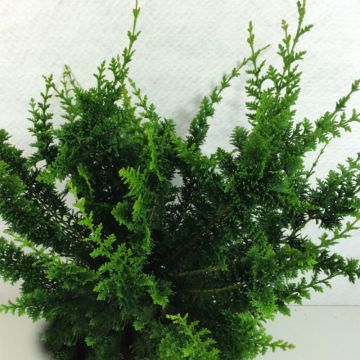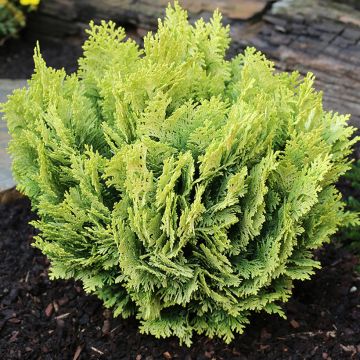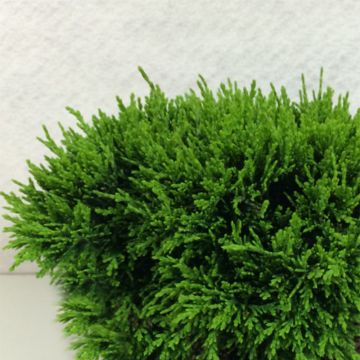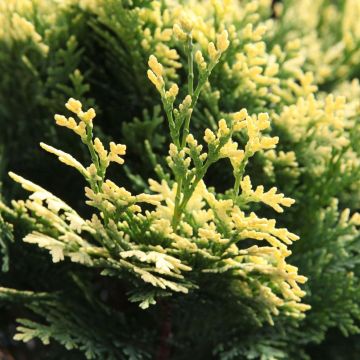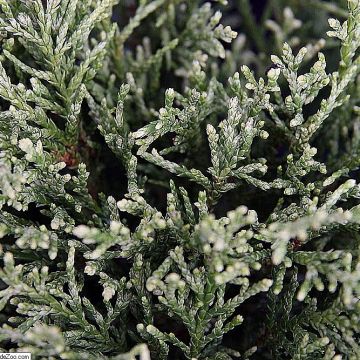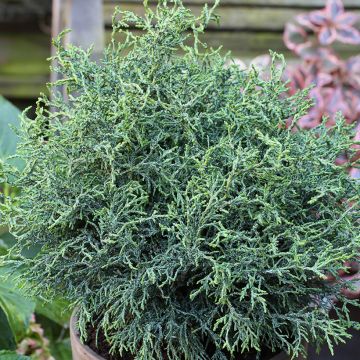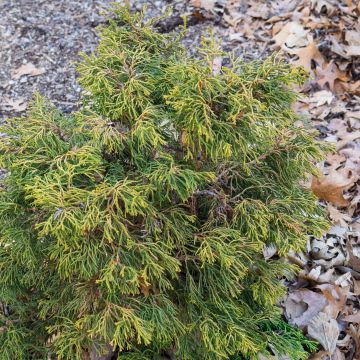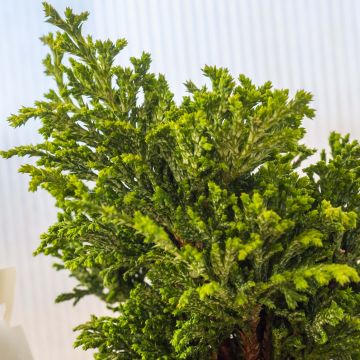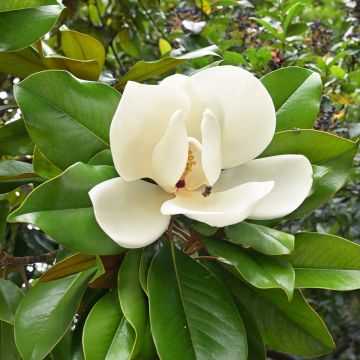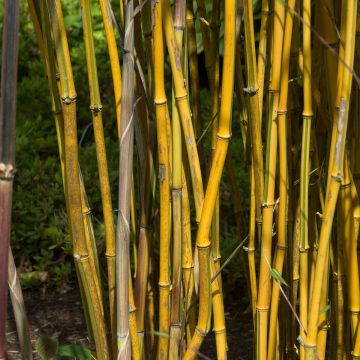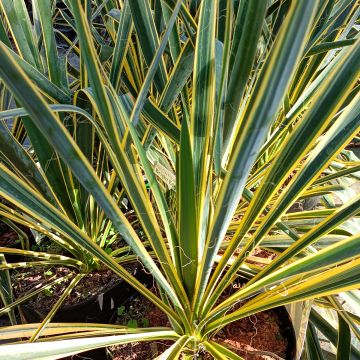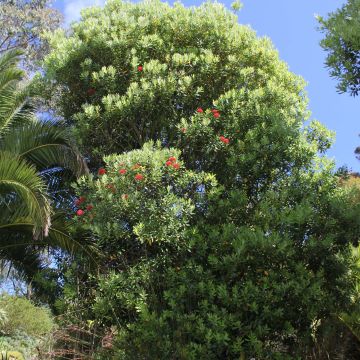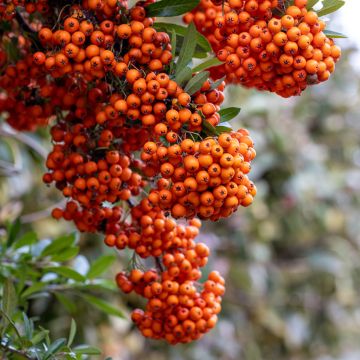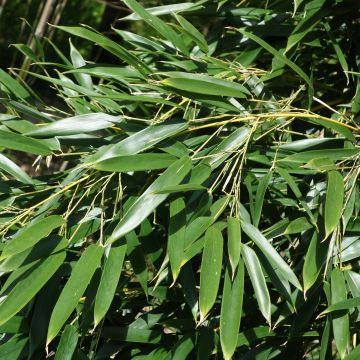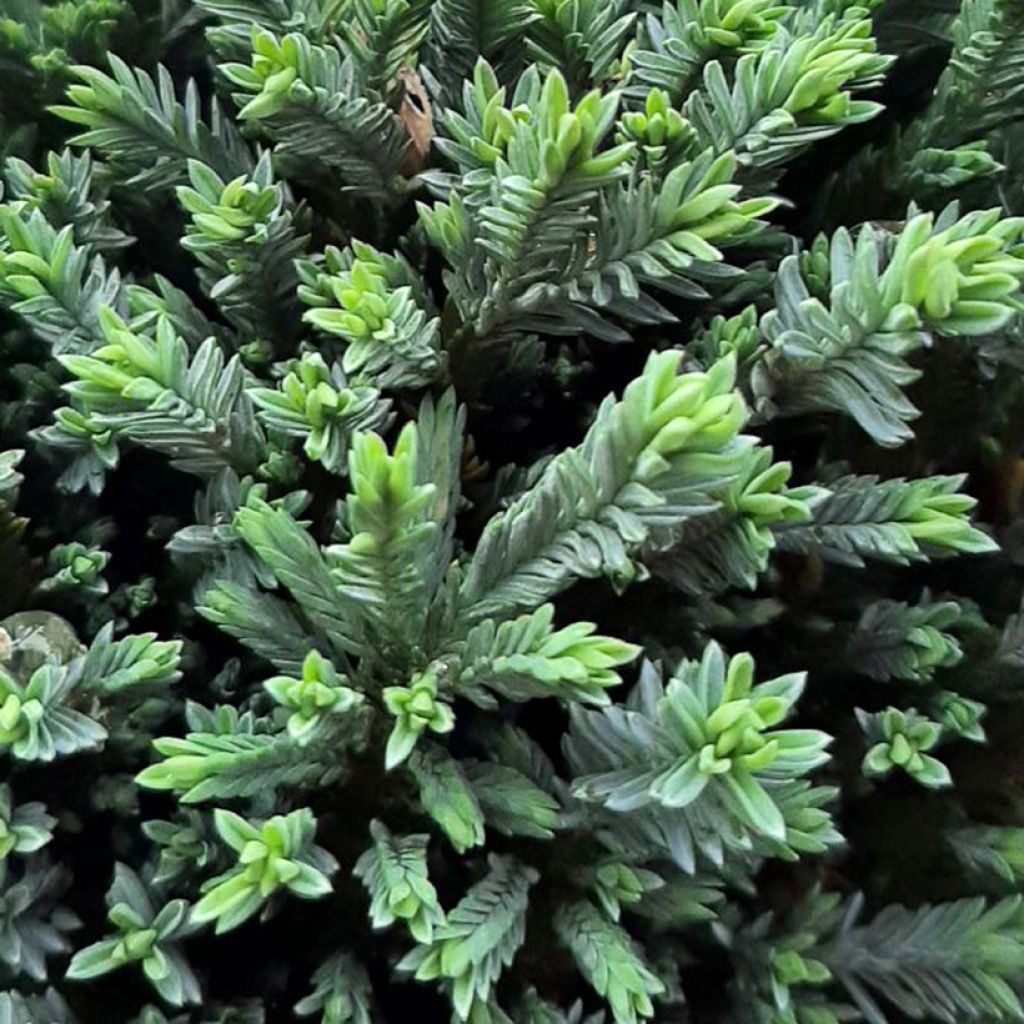

Chamaecyparis lawsoniana Rimpelaar - Lawson Cypress
Chamaecyparis lawsoniana Rimpelaar - Lawson Cypress
Chamaecyparis lawsoniana Rimpelaar
Lawson's Cypress, False Cypress, Port Orford-cedar, Oregon cedar, White cedar
This item cannot be shipped to the selected country
Delivery charge from €5.90
More information
Schedule delivery date,
and select date in basket
This plant carries a 24 months recovery warranty
More information
We guarantee the quality of our plants for a full growing cycle, and will replace at our expense any plant that fails to recover under normal climatic and planting conditions.
From €5.90 for pickup delivery and €6.90 for home delivery
Express home delivery from €8.90.
Does this plant fit my garden?
Set up your Plantfit profile →
Description
Chamaecyparis lawsoniana Rimpelaar is a dwarf variety of Lawson's Cypress that is interesting for its very dense ball-shaped habit and the beautiful colour of its foliage, bluish green with grey reflections. Its numerous very fine branches are covered with non-prickly needle-like scales, with a feathery appearance and a soft touch. Decorative all year round, slow-growing and not bulky, this conifer is ideal for enhancing small spaces, both in the ground and in pots.
The Lawson Cypress, in Latin Chamaecyparis lawsoniana, sometimes nicknamed false cypress, is a majestic conifer of the cupressaceae family native to the humid coastal forests of the northwest United States. In its natural habitat, it often reaches over 30m (98ft 5in) in height, with a trunk approaching 1.20m (3ft 11in) in diameter. Its habit is straight and conical, and its trailing branches form soft curtains adorned with fairly dark green foliage with bluish reflections. It has given rise to numerous cultivars, among which there is a wide choice of plants of modest stature, better suited to the size of our gardens.
The 'Rimpelaar' variety was discovered in Molenschot, the Netherlands. It is a "witch's broom" that appeared on a Chamaecyparis lawsoniana 'Ellwoodii' planted in Rimpelaar Street in this Dutch municipality. A witch's broom is a natural mutation frequently induced by the action of an aphid. This "anomaly" results in the formation of an intense branching that forms a ball, most often sterile, which shows leaves with a different appearance or colour. This 'Rimpelaar' cultivar shows a very dense, globose habit from a young age, becoming more regular over time. At the age of 10, it will form a bush of 60cm (23.6in) in all directions. Ultimately, its dimensions are estimated at 1.50m (4ft 11in) in all directions. It produces numerous slender and flattened branches covered with scale-like leaves, bluer when they emerge at the ends of the branches in spring, then taking on a more greyish hue the rest of the year.
The Chamaecyparis lawsoniana 'Rimpelaar' is a beautiful grey-blue cushion to be placed in a rock garden, a small urban garden, or a contemporary terrace. The architectural qualities of dwarf conifers deserve to be invited more often in our gardens, where they bring a permanent structure. These plants are discreet in summer and become prominent again in winter, when flowers have deserted our gardens. Perfect in a contemporary setting, conifers also have their place in more classic or even romantic landscapes: they mark pathways, border terraces and adorn the corner of a large shrub bed. To accompany the Lawson Cypress 'Rimpelaar', consider modest to medium-sized grasses such as Stipa tenuifolia, Pennisetum Hameln Gold, or Miscanthus Apetitiv.
Report an error about the product description
Chamaecyparis lawsoniana Rimpelaar - Lawson Cypress in pictures
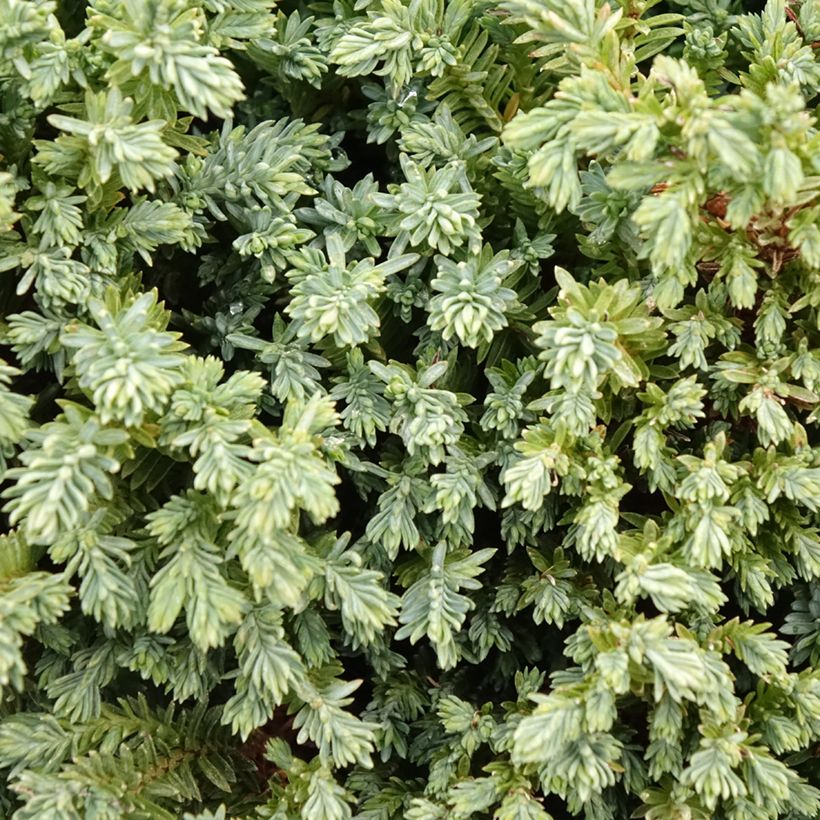

Plant habit
Foliage
Botanical data
Chamaecyparis
lawsoniana
Rimpelaar
Cupressaceae
Lawson's Cypress, False Cypress, Port Orford-cedar, Oregon cedar, White cedar
Cultivar or hybrid
Other Chamaecyparis
Planting and care
Chamaecyparis lawsonia 'Rimpelaar' should be planted in spring or autumn, in any well-drained soil, not too dry in summer, slightly acidic or neutral, or even slightly chalky. This conifer thrives in full sun (in a fairly humid climate) or partial shade. Water the plants regularly during the months following planting. This conifer is not too demanding of soil quality, but it suffers in excessively dry soils and arid conditions. It is a species suited to cool, oceanic or mountain climates. This bush does not tolerate heavy pruning, but you can remove any unsightly or obstructive branches. Remove branches that have uniformly green foliage and are much more vigorous.
Some varieties of chamaecyparis are particularly susceptible to a disease caused by a fungus called phytophthora, which can lead to their decline. Root rot, which thrives in damp soil, is a fungus that can develop on the roots of this conifer. When the fungus becomes visible on the trunk, it is too late to save the tree.
Planting period
Intended location
Care
This item has not been reviewed yet - be the first to leave a review about it.
Evergreen shrubs
Haven't found what you were looking for?
Hardiness is the lowest winter temperature a plant can endure without suffering serious damage or even dying. However, hardiness is affected by location (a sheltered area, such as a patio), protection (winter cover) and soil type (hardiness is improved by well-drained soil).

Photo Sharing Terms & Conditions
In order to encourage gardeners to interact and share their experiences, Promesse de fleurs offers various media enabling content to be uploaded onto its Site - in particular via the ‘Photo sharing’ module.
The User agrees to refrain from:
- Posting any content that is illegal, prejudicial, insulting, racist, inciteful to hatred, revisionist, contrary to public decency, that infringes on privacy or on the privacy rights of third parties, in particular the publicity rights of persons and goods, intellectual property rights, or the right to privacy.
- Submitting content on behalf of a third party;
- Impersonate the identity of a third party and/or publish any personal information about a third party;
In general, the User undertakes to refrain from any unethical behaviour.
All Content (in particular text, comments, files, images, photos, videos, creative works, etc.), which may be subject to property or intellectual property rights, image or other private rights, shall remain the property of the User, subject to the limited rights granted by the terms of the licence granted by Promesse de fleurs as stated below. Users are at liberty to publish or not to publish such Content on the Site, notably via the ‘Photo Sharing’ facility, and accept that this Content shall be made public and freely accessible, notably on the Internet.
Users further acknowledge, undertake to have ,and guarantee that they hold all necessary rights and permissions to publish such material on the Site, in particular with regard to the legislation in force pertaining to any privacy, property, intellectual property, image, or contractual rights, or rights of any other nature. By publishing such Content on the Site, Users acknowledge accepting full liability as publishers of the Content within the meaning of the law, and grant Promesse de fleurs, free of charge, an inclusive, worldwide licence for the said Content for the entire duration of its publication, including all reproduction, representation, up/downloading, displaying, performing, transmission, and storage rights.
Users also grant permission for their name to be linked to the Content and accept that this link may not always be made available.
By engaging in posting material, Users consent to their Content becoming automatically accessible on the Internet, in particular on other sites and/or blogs and/or web pages of the Promesse de fleurs site, including in particular social pages and the Promesse de fleurs catalogue.
Users may secure the removal of entrusted content free of charge by issuing a simple request via our contact form.
The flowering period indicated on our website applies to countries and regions located in USDA zone 8 (France, the United Kingdom, Ireland, the Netherlands, etc.)
It will vary according to where you live:
- In zones 9 to 10 (Italy, Spain, Greece, etc.), flowering will occur about 2 to 4 weeks earlier.
- In zones 6 to 7 (Germany, Poland, Slovenia, and lower mountainous regions), flowering will be delayed by 2 to 3 weeks.
- In zone 5 (Central Europe, Scandinavia), blooming will be delayed by 3 to 5 weeks.
In temperate climates, pruning of spring-flowering shrubs (forsythia, spireas, etc.) should be done just after flowering.
Pruning of summer-flowering shrubs (Indian Lilac, Perovskia, etc.) can be done in winter or spring.
In cold regions as well as with frost-sensitive plants, avoid pruning too early when severe frosts may still occur.
The planting period indicated on our website applies to countries and regions located in USDA zone 8 (France, United Kingdom, Ireland, Netherlands).
It will vary according to where you live:
- In Mediterranean zones (Marseille, Madrid, Milan, etc.), autumn and winter are the best planting periods.
- In continental zones (Strasbourg, Munich, Vienna, etc.), delay planting by 2 to 3 weeks in spring and bring it forward by 2 to 4 weeks in autumn.
- In mountainous regions (the Alps, Pyrenees, Carpathians, etc.), it is best to plant in late spring (May-June) or late summer (August-September).
The harvesting period indicated on our website applies to countries and regions in USDA zone 8 (France, England, Ireland, the Netherlands).
In colder areas (Scandinavia, Poland, Austria...) fruit and vegetable harvests are likely to be delayed by 3-4 weeks.
In warmer areas (Italy, Spain, Greece, etc.), harvesting will probably take place earlier, depending on weather conditions.
The sowing periods indicated on our website apply to countries and regions within USDA Zone 8 (France, UK, Ireland, Netherlands).
In colder areas (Scandinavia, Poland, Austria...), delay any outdoor sowing by 3-4 weeks, or sow under glass.
In warmer climes (Italy, Spain, Greece, etc.), bring outdoor sowing forward by a few weeks.

































